Unit 2 - The Definition of Work
Learning Objective: Understand and be able to explain the relationship between money, work, and power, and how energy resources like oil and natural gas amplify productivity far beyond human or animal labor.

Unit Outline
2.1 The Definition of Work
2.2 The Definition of Power
2.3 The Laws of Thermodynamics and Their Economic Implications
2.4 The Evolution of Work
2.4.1 Manpower
2.4.2 Horsepower
2.4.3 Petroleum Power
2.5 Engines and Work
2.7 Energy Sources
2.7.1 Energy Consumption by Source – Global
2.7.2 Energy Consumption by Source – U.S.
2.7.3 Consumers of Energy
2.7.4 Global Oil Consumption
2.8 Controlling Access to and Consumption of Energy Resources
2.1 The Definition of Work
In everyday terms, work refers to physical or mental effort toward a purpose or necessity. According to Webster’s Dictionary, it is defined as:
“Physical or mental exertion in sustained effort for a purpose or under compulsion or necessity.”
In physics, work has a more specific meaning: it is done when a force causes an object to move over a distance. The formula is:
Work = Force × Displacement (W = F × s)
Example: Work is done when a farmer moves soil to plant seeds, which then grow and are harvested. Additional work is required to grind the grain into flour, mix it into dough, and bake it into bread.
2.2 The Definition of Power
Power measures how quickly work is performed. It is calculated as:
Power = Work ÷ Time
Or rearranged:
Work = Power × Time
In practical terms, power reflects productivity—the rate at which work is completed. A stronger, faster farmer planting a field in half the time demonstrates twice the power (and productivity) of a slower farmer.
Power is fundamental to economic growth. Societies with greater access to energy resources can produce more output, build infrastructure, and improve living standards faster than those with limited energy availability.
2.3 The Laws of Thermodynamics and Their Economic Implications
The laws of thermodynamics explain the relationship between energy, work, and efficiency. These laws not only govern physical systems but also provide insights into economic processes and productivity.
First Law of Thermodynamics (Conservation of Energy):
Energy cannot be created or destroyed, only transferred or transformed.
- Economic Implication: Resources are finite, and the energy used to fuel growth must be harnessed from existing sources like fossil fuels, solar, or wind power. Transforming energy into useful work drives production and value creation.
Second Law of Thermodynamics (Entropy):
Energy naturally tends to disperse, and systems move toward disorder unless energy is added to restore order.
- Economic Implication: Work requires effort and energy input to overcome disorder. For example, growing food, refining metals, or manufacturing goods requires energy to bring order out of chaos.
Key Insight:
Productivity and economic growth depend on the ability to harness energy efficiently. Societies with abundant, accessible energy resources (like fossil fuels) can perform more work and achieve higher living standards.
2.4 The Evolution of Work
The evolution of work can be divided into three major phases:
2.4.1 Manpower
Early civilizations relied entirely on human labor. A healthy person can generate approximately 75 watts of power per hour, consuming about 300 calories per hour during physical labor.
2.4.2 Horsepower
The domestication of animals, such as horses, increased productivity. A horse generates around 750 watts per hour—about 10 times the power of a human—and consumes roughly 3,000 calories per hour.
2.4.3 Petroleum Power
The invention of internal combustion engines unlocked the energy in fossil fuels.
- 1 gallon of gasoline contains about 36,000 watt-hours—enough energy to do the work of 50 horses for one hour or replace 10 days of human labor (3,000 calories/day).
- Fossil fuels transformed labor, enabling unprecedented productivity and economic growth.
2.5 Engines and Work
Engines convert energy into mechanical power, enabling vast amounts of work. The steam engine (18th century) and internal combustion engine (19th century) replaced human and animal labor, paving the way for industrialization and modern economies. By 1944, gasoline-powered tractors had largely replaced horses on U.S. farms, illustrating the transformative role of fossil fuels in labor productivity.
2.6 Labor Productivity
Labor productivity measures economic output (GDP) per hour of work. With fossil fuels and machines, productivity soared.
In 1 A.D., world GDP was $182.74 billion per the chart below:
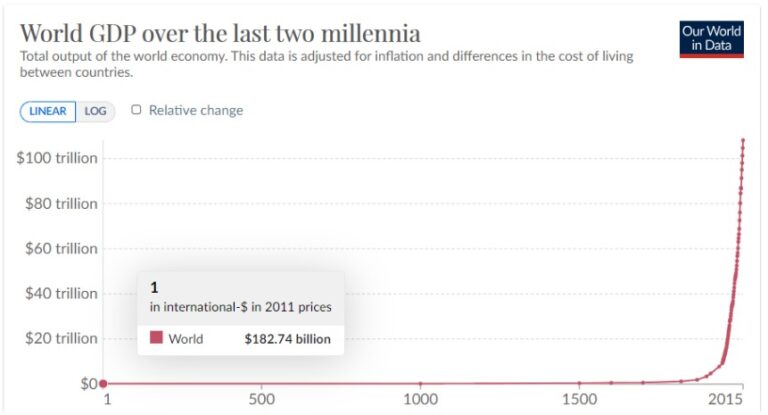
In 1940 A.D., world GDP was $7.8 trillion per the chart below:
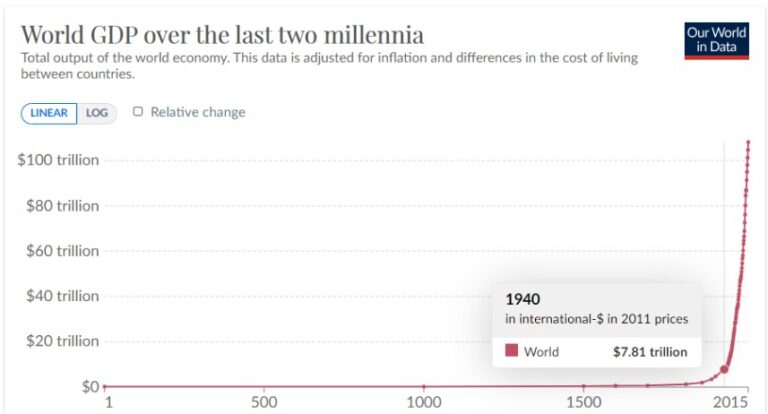
In 2015, world GDP was $108.12 trillion per the chart below:
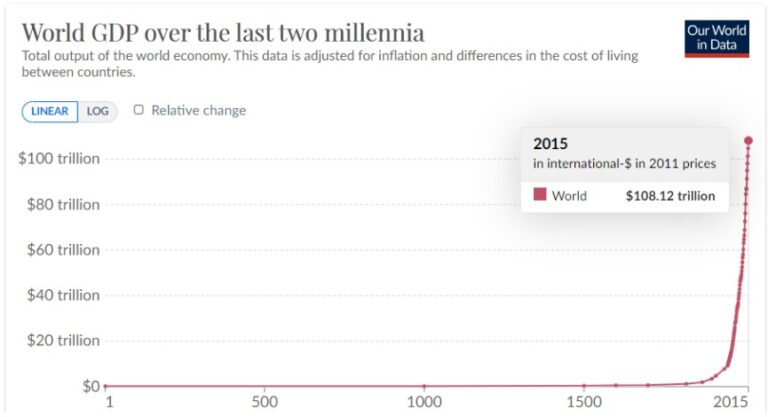
While GDP increased astronomically, the amount of time spent working was cut in half:
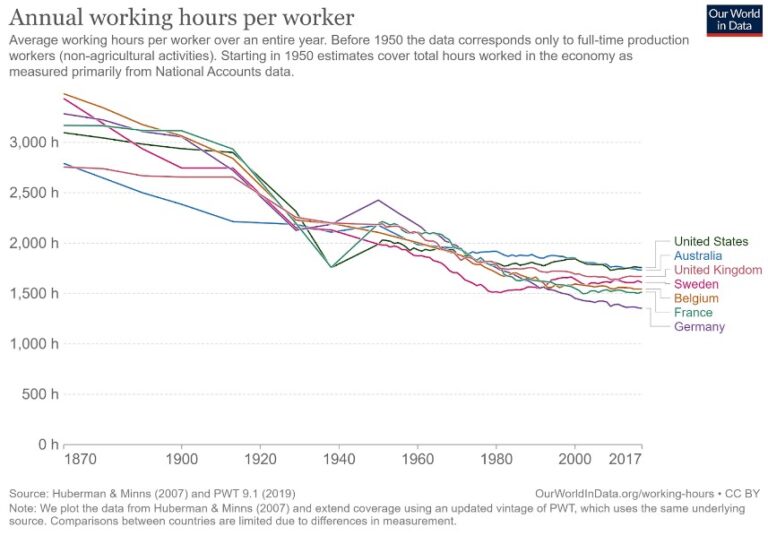
Machines and energy resources reduced manual labor while increasing output. Population growth also surged, reflecting greater economic capacity.
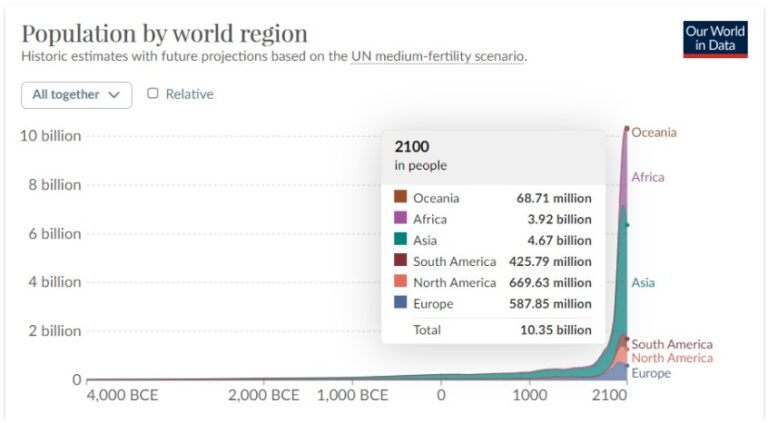
2.7 Energy—The Fuel for Work
Modern civilization depends on energy to sustain productivity and living standards.
2.7.1 Global Energy Consumption:
The 20th century saw a dramatic rise in fossil fuel consumption, powering industry, transportation, and households.
The following chart shows energy consumption by source for the year 1900 AD:
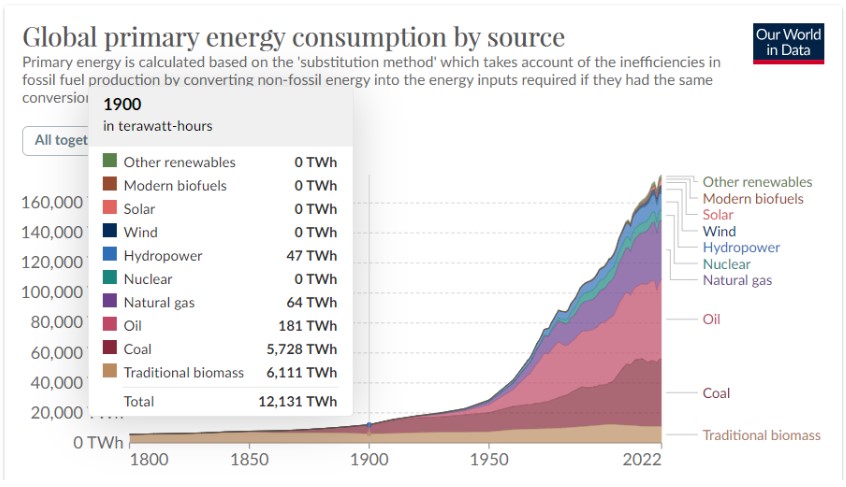
Compare the amounts a hundred years later (y2k):
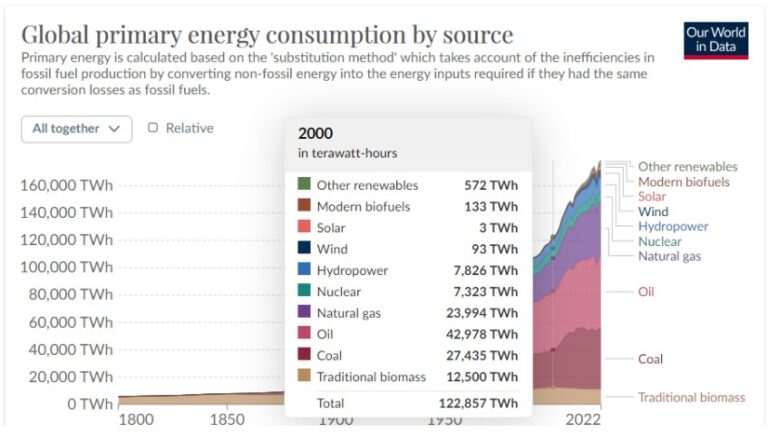
2.7.2 U.S. Energy Consumption:
According to the U.S. Energy Information Administration (EIA), 90.7% of our energy/power comes from non-renewable sources. Only 9.3% comes from renewable energy sources. Note that Oil (Petroleum) and Gas (Natural) account for over 60% of our energy used.
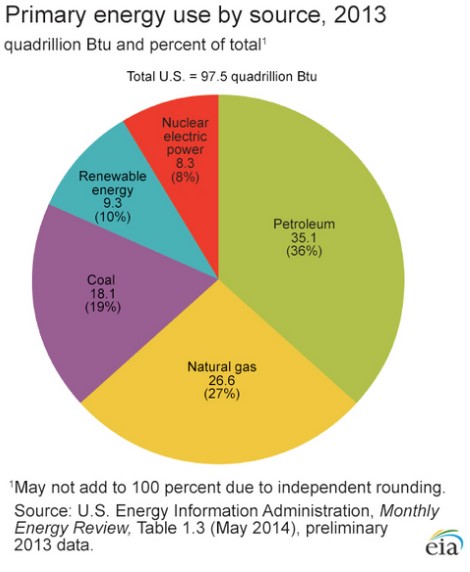
Minimal changes have occurred since 2013. The chart below is for 2021:
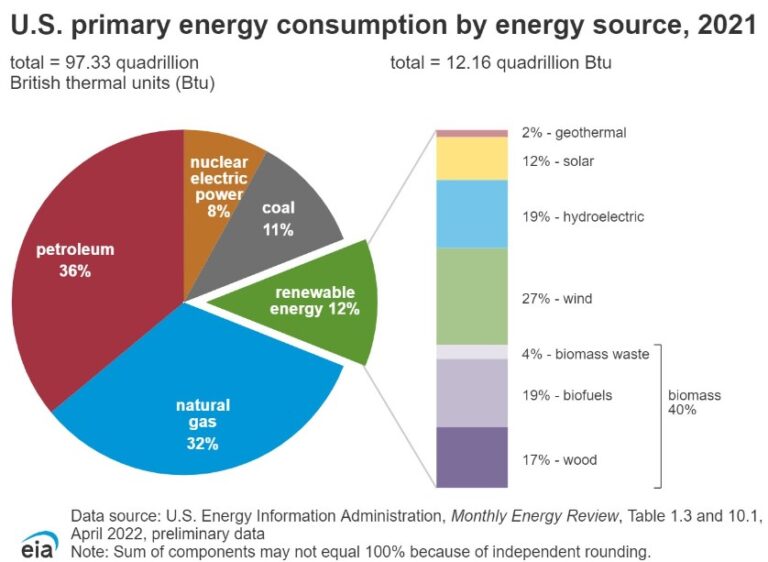
2.7.3 Energy Usage by Region:
North Americans consume significantly more energy per capita than other regions, reflecting their industrialized economies and high living standards.
Data source: http://data.worldbank.org/indicator/EG.USE.PCAP.KG.OE/countries/1W?display=default
Chart: TheSubjectOfMoney.org
2.7.4 Global Oil Consumption:
As of 2022, the world consumes over 4 billion (97 million barrels/day * 42 gallons/barrel) gallons of oil daily, a testament to the critical role fossil fuels play in the global economy.
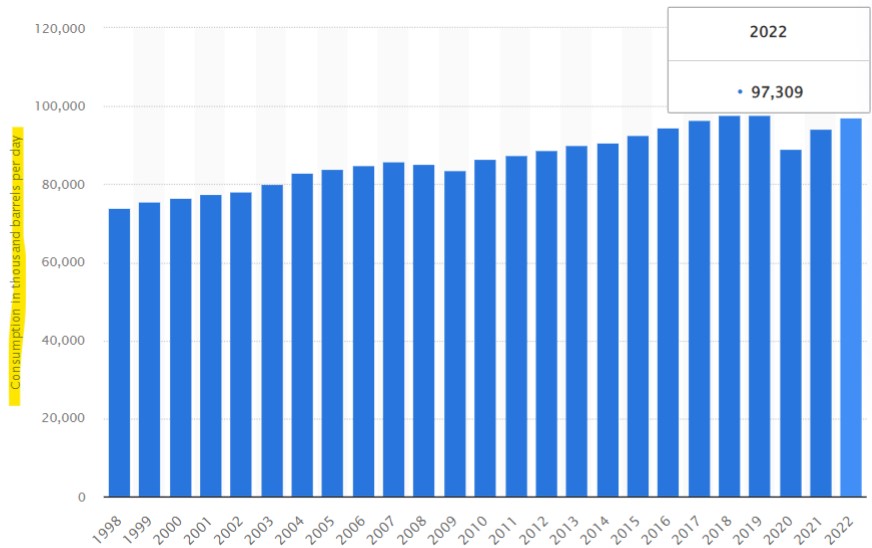
2.8 Controlling Access to and Consumption of Energy Resources
Energy resources such as oil, coal, and natural gas are central to modern economies. Nations that control energy supplies influence global trade, military power, and economic development.
Access to energy defines geopolitical power, while technological advances in energy extraction and distribution continue to reshape economic competition.
Conclusion:
Work is the foundation of all economic activity, value creation, and wealth accumulation. From early human labor to horsepower and fossil-fuel-powered machinery, the evolution of work has been driven by humanity’s ability to harness energy more efficiently. Each step in this progression—from manual labor to mechanical engines—has allowed societies to perform exponentially more work, enabling technological advancements, industrialization, and rising living standards.
In this unit, we explored the definitions of work and power, demonstrating how energy is required to transform resources into valuable goods and services. We examined how labor productivity and economic output have skyrocketed with access to high-energy-density fuels like oil and natural gas, amplifying the capacity for nations to create wealth.
We also introduced the laws of thermodynamics, which reveal the fundamental principles governing energy, work, and efficiency. The First Law explains that energy must be conserved, while the Second Law highlights the natural tendency toward disorder—requiring energy input to maintain order and sustain economic systems. These scientific laws underscore the critical relationship between energy availability and economic productivity.
Finally, we analyzed how controlling access to energy resources translates into geopolitical and economic power. Countries rich in energy reserves—or with the ability to secure and distribute energy—enjoy outsized influence in global markets, military strength, and industrial output.
Key Takeaway:
Work is inseparable from energy. Wealth, productivity, and economic stability all depend on a society’s ability to harness and apply energy effectively. Fossil fuels and modern technologies have multiplied human productivity, enabling unprecedented growth and prosperity, but this progress is also tied to energy security and resource management.

